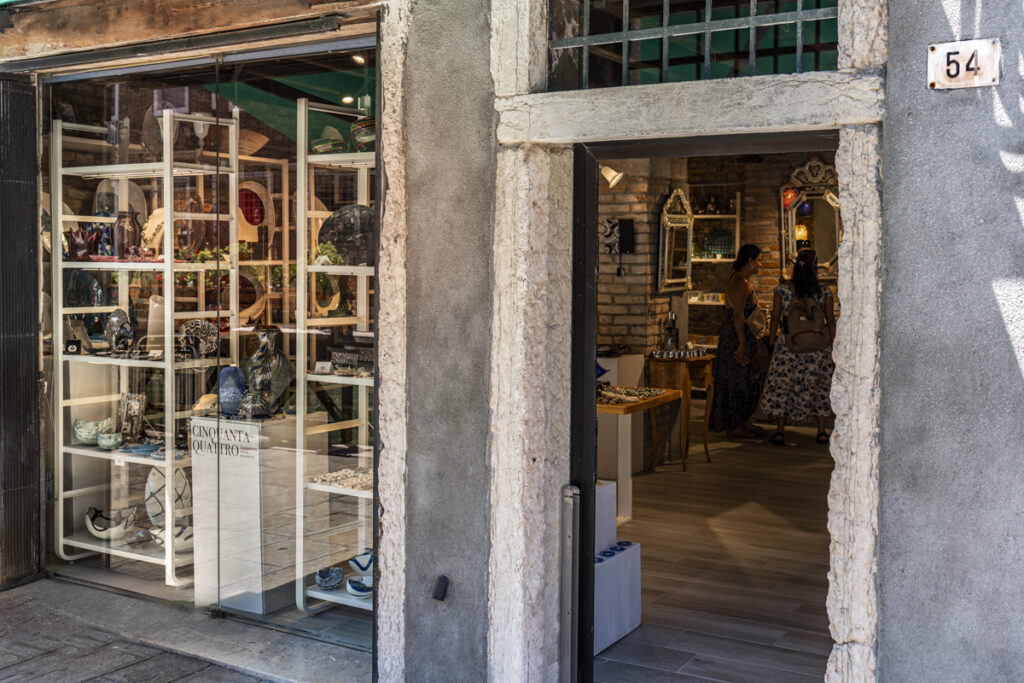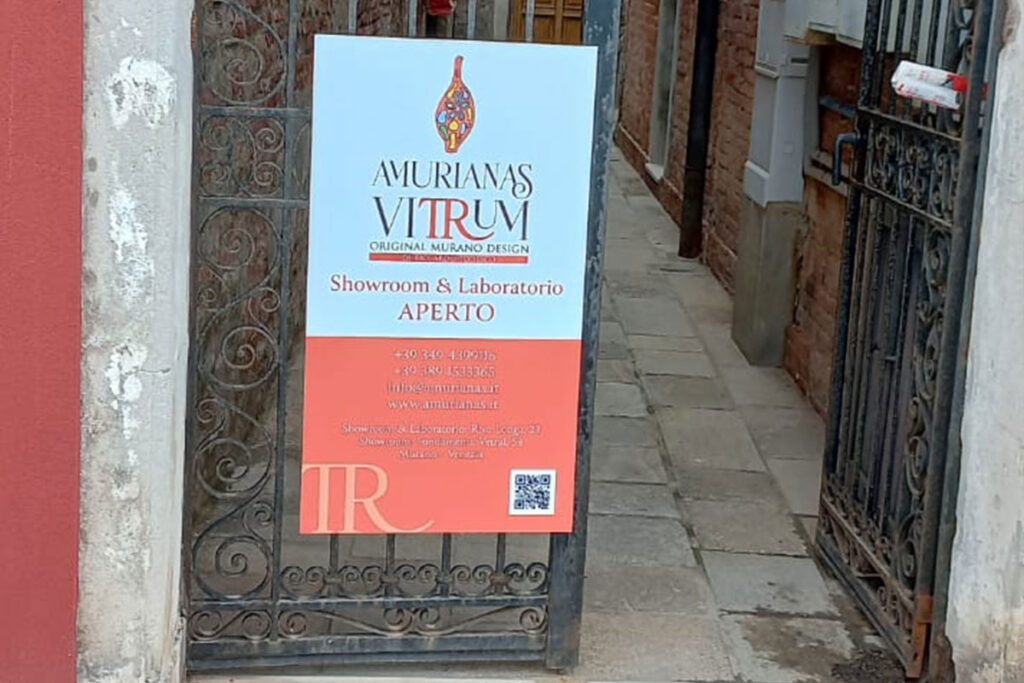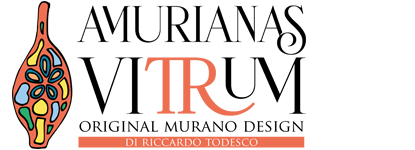


Our History
Amurianas Vitrum, Riccardo Todesco’s Laboratory, with 2 Show-Rooms, works in the production of artistic glass, in the heart of Murano.
Founded by the young venetian artisan Riccardo Todesco, after graduating in Economics, he followed his love and passion for Murano glass and its story by founding Amurianas Vitrum.
the processing varies from the glass blowing technique to the milling technique. In the Lab, seeing its creation, you can find a large variety of different objects in glass with murrine, to decorate your house and to grace your table. You can also find a range of jewelry products with special Murano beads.
Tradition and Innovation
Since 1200 Murano took on a strategic role for the Serenissima Republic of Venice; to avoid fires in the main island all the laboratories and glass factories were moved in the island of Murano.
The trade and tradition of glass making continues to thrive to this day. Amurianas Vitrum is an innovative artisanal enterprise that keeps the tradition alive and unaltered with the production of precious glass objects.
Custom-made
Creativity is our forte!
Amurianas vitrum makes both traditional objects and unique custom-made pieces, with the appropriate techniques for the desired result. All the custom-made pieces are marke in the catalogue and can also be requested online.
Laboratory
You can find Amurianas Vitrum’s Lab in Riva Longa 23, Murano. In the numerous rooms of the Lab you can feel the vivacity of artisanal life and be astonished by the making of all kinds of glass objects, from tableware to jewelry. In the lab you will find all the raw materials and machinery for the production and molding of glass, along with the furnace for the fusion.
ARTISTIC LABORATORY
There are three main Murano glass making techniques:
blown- glass, fusion-glass and lampworking.
GLASS MAKING TECHNIQUES
Blown glass
Blown glass dates back to the I Century B.C., but since the Middle Ages the maestri muranesi showed an exstraordinary ability in glass blowing. This niche ability allowed them to invent new techniques and create highly refined artifacts. A bowl of liquid glass is placed at the end of a glass-maker’s stick, a sort of massive straw, air is then blown into the tube making the glass sphere inflate. The glass bubble is then modelled with various instruments in order to obtain the desired shape.
Fusion-glass
It’s an ancient technique which also comprehends mosaic glass. Little pieces of different colors are assembled on a ceramic fiber plate and fused in an electric oven to obtain a multicolored glass plate called vetro mosaico or murrina. Tiny pieces of glass called graniglia are placed on the ceramic fiber plate and fused together. This process can be repeated many times layering the colors and creating a 3D decore. To give the objects their desired shape a second fusion is done in moulds.
Fusion-glass
It’s an ancient technique which also comprehends mosaic glass. Little pieces of different colors are assembled on a ceramic fiber plate and fused in an electric oven to obtain a multicolored glass plate called vetro mosaico or murrina. Tiny pieces of glass called graniglia are placed on the ceramic fiber plate and fused together. This process can be repeated many times layering the colors and creating a 3D decore. To give the objects their desired shape a second fusion is done in moulds.

Lampworking
This technique is mainly used to create glass miniatures and most little glass objects. The artisan using a torch, powered by gas and oxygen, melt together some glass wands, previously made in the glass factory.
Vetro murrino
Murrino glass is one of the oldest techniques, it is a secondary process which consists of a glass plate composed by heat welding glass tiles of different colors sectioned by polychrome rods. The plate is then modeled using a refractory clay mold and can be further modified even taking the shape of a vase
Vetro murrino
Murrino glass is one of the oldest techniques, it is a secondary process which consists of a glass plate composed by heat welding glass tiles of different colors sectioned by polychrome rods. The plate is then modeled using a refractory clay mold and can be further modified even taking the shape of a vase
VETRO ARTISTICO® MURANO'S CERTIFICATE

In 1985, a group of companies with the help of Confartigianato Venezia, decided to set up Promovetro consortium, with the aim of preserving and promoting artistic Murano glass. The brand Vetro Artistico® Murano was born in 1994 to guarantee the authenticity of products made in Murano, in fact only the laboratories based in Murano can apply to became dealerships of the brand.
Promovetro, in its own right, can be considered one of the main custodians of the production of original Murano artistic glass. The Consortium can proudly declare that the consortium’s artisan and industrial companies produce artistic glass in a completely artisanal way, piece by piece, with a lot of work and limited technology in compliance with the authentic Murano tradition.
WHER YOU FIND US

SHOW ROOM
Fondamenta Vetrai n. 54 Murano, Venezia, Italia
Linea 4.1 - FERMATA COLONNA
@font-face
{font-family:"Cambria Math";
panose-1:2 4 5 3 5 4 6 3 2 4;
mso-font-charset:0;
mso-generic-font-family:roman;
mso-font-pitch:variable;
mso-font-signature:3 0 0 0 1 0;}@font-face
{font-family:Calibri;
panose-1:2 15 5 2 2 2 4 3 2 4;
mso-font-charset:0;
mso-generic-font-family:swiss;
mso-font-pitch:variable;
mso-font-signature:-536859905 -1073732485 9 0 511 0;}p.MsoNormal, li.MsoNormal, div.MsoNormal
{mso-style-unhide:no;
mso-style-qformat:yes;
mso-style-parent:"";
margin:0cm;
mso-pagination:widow-orphan;
font-size:12.0pt;
font-family:"Calibri",sans-serif;
mso-ascii-font-family:Calibri;
mso-ascii-theme-font:minor-latin;
mso-fareast-font-family:Calibri;
mso-fareast-theme-font:minor-latin;
mso-hansi-font-family:Calibri;
mso-hansi-theme-font:minor-latin;
mso-bidi-font-family:"Times New Roman";
mso-bidi-theme-font:minor-bidi;
mso-font-kerning:1.0pt;
mso-ligatures:standardcontextual;
mso-fareast-language:EN-US;}.MsoChpDefault
{mso-style-type:export-only;
mso-default-props:yes;
font-family:"Calibri",sans-serif;
mso-ascii-font-family:Calibri;
mso-ascii-theme-font:minor-latin;
mso-fareast-font-family:Calibri;
mso-fareast-theme-font:minor-latin;
mso-hansi-font-family:Calibri;
mso-hansi-theme-font:minor-latin;
mso-bidi-font-family:"Times New Roman";
mso-bidi-theme-font:minor-bidi;
mso-font-kerning:1.0pt;
mso-ligatures:standardcontextual;
mso-fareast-language:EN-US;}div.WordSection1
{page:WordSection1;}

